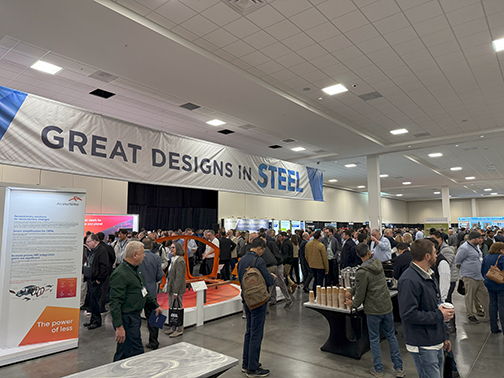We had a great time at Great Designs in Steel in May and enjoyed many face-to-face interactions with our members, colleagues and friends. Following is a list of presentations conducted or facilitated by Auto/Steel Partnership staff and members and a link to download each. If you’d like access to all of the 2025 GDIS presentations as well as past years, you can find them on the American Iron and Steel Institute’s website here. Hope to see you at 2026 Great Designs in Steel, to be held on May 20, 2026!
Track 1 – 1:30 PM – Automotive Panel: Artificial Intelligence in Automotive Steel
@Michael Davenport, A/SP Executive Director, moderated the panel. @Eric McCarty, A/SP Senior Project Manager, will be a presenter and panelist alongside @Dr. Sheng-Dong Liu, Generalety, LLC, and @FADI Abu-Farha, Material Insights. Following are the panelists’ presentation downloads:
- The Application of Artificial Intelligence and Machine Learning for Steel Characterization and Modeling, by Eric McCarty.
- AI-Driven Innovations for Steel Vehicle Structural Design, by Dr. Sheng-Dong Liu
- Toward New Automotive Steel Developments Driven by Big DATA & AI, by Dr. FADI Abu-Farha
Track 2 – 2:45 PM – Laser Hardening of Cutting Dies (Semi Industrial) Trial
Speaker J.P. Singh, General Motors Company
This presentation summarized work of the Auto/Steel Partnership project, Laser Hardening of Cutting Dies (Semi Industrial) Trial Project, a durability study using trim dies in a mechanical press. Three different material and manufacturing process routes are proposed for the study. (1) S7 as received + laser hardening, 4140 (pre-hardened) + laser hardening, and Caldie (through hardened). The project utilizes a DP980 material in the press at 100,000 hits.
Download Laser Hardening of Cutting Dies (Semi-Industrial) Trial, by J. P. Singh
Track 3 – 1:30 PM
There are two presentations being presented in the same time slot as follows:
Deformation and Edge Stretchability of Multi-phase Steels After Shear Cutting
Speaker Advaith Narayanan, University of Waterloo
Advanced High-Strength Steels (AHSS) with a multiphase microstructure can exhibit a high sensitivity to shear cutting by virtue of centerline segregation defects or presence of hard inclusions embedded in the material. The edge stretchability limits, and location of fracture initiation can be significantly affected by the applied loading which can activate these defects promoting premature failure in specific areas of stamped components. The high edge sensitivity can also lead to localized straining in a narrow band behind the cut edge that can be difficult to characterize using conventional methods. In this study, the strains in the shear affected zone (SAZ) after hole punching as well as the subsequent edge stretchability were investigated for two MP steels having a nominal tensile strength of 800 MPa but with different local formabilities and underlying fracture mechanisms. First, hardness maps were generated from hole punched coupons using four different clearances to assess the SAZ depth and strain. An alternative technique to characterize the SAZ based upon real-time strain data acquisition during punching using digital image correlation (DIC) was investigated. Secondly, cutting clearance was investigated in conical hole expansion tests that promote out-of-plane loading of the sheared edge. Thirdly, in-plane bending and hole tension tests were performed for the clearance corresponding to the highest edge formability to assess the sensitivity of the fracture limits to the boundary conditions. Lastly, recommendations and best practices for efficient characterization of SAZ and edge fracture limits for multiphase steels are proposed.
Download Deformation and Edge Stretchability of Multi-phase Steels After Shear Cutting, by Advaith Narayanan
A New Methodology to Characterize the Influence of Pre-Straining on the Bake Hardening Response of 3G AHSS
Speaker Rhys Northcote, University of Waterloo
The existing ASTM A653 standard for determining the bake hardening index (BHI) of sheet metals is primarily defined for a pre-strain level of 2% and has been shown to induce premature transition radius failure for higher pre-strains in select third generation advanced high strength steels (3G-AHSS). To this end, a new test procedure to characterize the BHI is developed and applied to 980 MPa and 1180 MPa 3G-AHSS. The proposed KS-1B methodology involves pre-straining over-sized tensile specimens followed by extraction of an ASTM E8 sample that is then paint baked and tested to determine the BHI. The KS-1B methodology is applied to determine the BHI for four pre-strain levels between 2 to 10% with results compared to the ASTM A653 standard for pre-strain levels of 2 and 8%. Finally, the paint bake influence is investigated for a case of significant pre-strain using the sheared edge conical hole expansion tests conducted with and without baking. It is found that the tensile mechanical properties of the 3G steels after paint baking were sensitive to the pre-strain with bake hardening indices exceeding 100 MPa. However, the sheared edge formability evaluated through the conical hole expansion tests was not significantly affected by the paint bake cycle.
Download A New Methodology to Characterize the Influence of Pre-Straining on the Bake Hardening Response of 3G AHSS, by Rhys Northcote
Track 3 – 4:00 PM
Repairability of 3rd Gen AHSS
Speaker Justin Hunt, Stellantis
This presentation summarizes the work of the Auto/Steel Partnership project, Repairability of 3rd Gen Advanced High Strength Steels (AHSS), which is focused on the evaluation of various weld repair processes and to provide joint test data for use by OEMs. The materials tested was 980 3rd Gen AHSS. The presentation will also investigate the effects of laser welding. The repair process joints were destructively tested. The test parameters included shear tension and cross tension quasi-static, shear tension fatigue, and cross-sections. The resulting data can be used by OEMs to update repair process strategies using these 3rd Gen Advanced High-Strength Steels.
Download Repairability of 3rd Gen AHSS, by Justin Hunt

